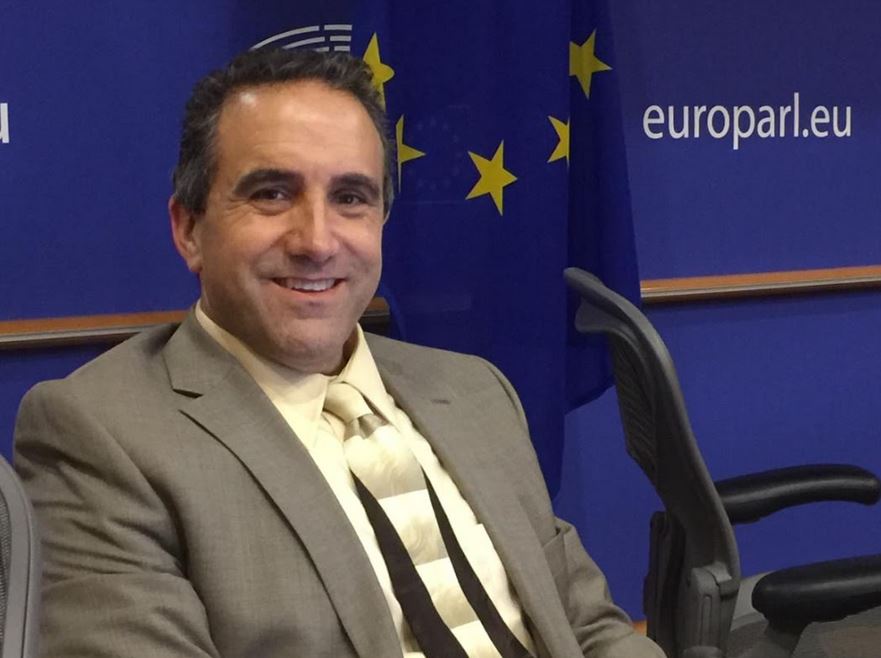By David Whitehouse, GWPF Science Editor
It’s that time of year when the minimum ice extent in the Arctic. One common way to look at it is to pick a particular month and wield a straight line. Fig 1 is from 1979 showing the ice extent going down and down, prompting claims of an ice-free Arctic sometime in the near future. It shows the declining Arctic ice cover which seems precipitous until one considers that it is a decline of about 10% by its measure of ice extent in 35 years! Important certainly but not as dramatic as the graph shows. But with graphs like those one needs to step back and consider the context, for it does not show what it appears to.
Between 1979 and 2015 – the years covered by the graph – atmospheric CO2 levels increased a lot, from 340 ppm to 400 ppm. To put it into context the increase from 1960 to 1979 was just 25 ppm. Fig 1 shows that during this unprecedented increase the gradient – the rate of decline – of the sea ice loss remained constant. In other words the addition of almost 20% of CO2 into the atmosphere did not change the behaviour of the sea ice at all. If one was being strict, based only on the arctic ice data and CO2 information, one would have to conclude that there is no correlation between Arctic sea ice extent and atmospheric CO2 levels! Surely one might have expected the more CO2 in the atmosphere the greater would be the so-called polar amplification effect, and the greater the decline in the rate of loss of sea ice.
As I wrote when looking at last year’s data the declining Arctic ice cover has been one of the most powerful images of climate change and that many who follow the debate don’t look too hard at the data. This results in superficial reporting that does not convey any of the complexities of the situation and as such is poor science communication.
Last year a suggestion (which had been made before) that Arctic ice was more resilient that was thought prompted much discussion but little media coverage despite the research being published in Nature Geoscience by Tilling at el (2015)called “Increased Arctic sea ice volume after anomalously low melting in 2013.” The headline was that the volume of Arctic sea ice increased by about a third after an unusually cool summer in 2013. Reports went on to say that the unusual growth continued in 2014 and more than compensated for the loss in the three previous tears. Overall it was concluded that changes in summer temperatures in the Arctic have a greater impact on the ice than was thought.
With the data for 2016 now in it is time to look again at the claims of an “ice pause.” Fig 2 shows the latest situation usingone measure of sea ice extent.
This years minimum was reached on day 254 (September 10th) of the year (nothing unusual). The minimum ice extent was also nothing unusual at 4.1 million km2, not the lowest and about the same as 2007. Some media reports portrayed this as the second lowest (behind the anomalous year of 2012) and mentioned its comparison with 2007 without making the obvious comment that it was curious in these days of much talk of rapid ice decline in the Arctic that the minimum extent was the same as it was 9 years ago!
Here is the minimum extent since 2007 (millions of sq km) and it is obvious there is no general decrease in minimal ice area, by this measure, between 2007 – 2016 – ten years! Did anyone run the headline that Arctic minimum ice extent has showed no significant change in the past decade? The case can be made that the behaviour of the Arctic ice cover has changed from the declining years of 1998 – 2007.
Feedback: [email protected]






2 Responses
Just where is the evidence for this “Polar Amplification”?
https://uploads.disquscdn.com/images/3760ffb30ebe8df9c982a0c233d8061d86679a221223a35cf6a9a7e4c5282d30.jpg
Well, it is not found in the RSS satellite record of Antarctica…
https://uploads.disquscdn.com/images/c6e8923ba06b1c45dd80a032e25925139fc6408afccb52b2a1abdf4a7b97db86.jpg
Not in this paper…of Antarctica …
https://uploads.disquscdn.com/images/61b29f5aeb366a2d3f5bb1399d5c12a77c6999ae48a542f75faf672faae7f250.jpg
Just where is the evidence for this “Polar Amplification”?
Karl 1993: ”Few of the trends are significant, large surface warming trends are not observed, and, like the Western Arctic Ocean analysis in Table 1, significant surface cooling trends are found during winter and autumn. Significant warming tends are observed at the 850 hPa level, and the 850-700 hPa layer during winter, in agreement with GCM simulations, but the surface trend is negative. The trends presented in Table 2 are more representative, temporally, as they use the 36-38 years in the regional analysis (Table 1). On the basis of these tests, we feel that any possible bias introduced by the non-uniform database, is small. The lack of widespread significant warming trends leads us to conclude that there is no strong evidence to support model simulations of greenhouse warming over the Arctic Ocean for the period 1950-1990. Our results, combined with the inconsistent performance of model simulations of Arctic climate 6 indicate a need to understand, better, the physical processes that affect the polar regions, especially atmosphere-ice-ocean interactions, ocean heat transfer and cloud radiative effects, and to incorporate thermodynamic sea-ice components in to future models.”
Kahl, Jonathan D., et al. 1993 “greenhouse warming over the Arctic Ocean in the past 40 years.” Nature
https://uploads.disquscdn.com/images/08c91f7ebe6e192d245d10ac6a831f9b8a3603b51aa1644a7fab10c42522fabb.jpg
https://uploads.disquscdn.com/images/5dfdfe64ae31ec6734dbc57adbc4aae51bdfb885f8d90180af61b42f5b1bcc9c.jpg